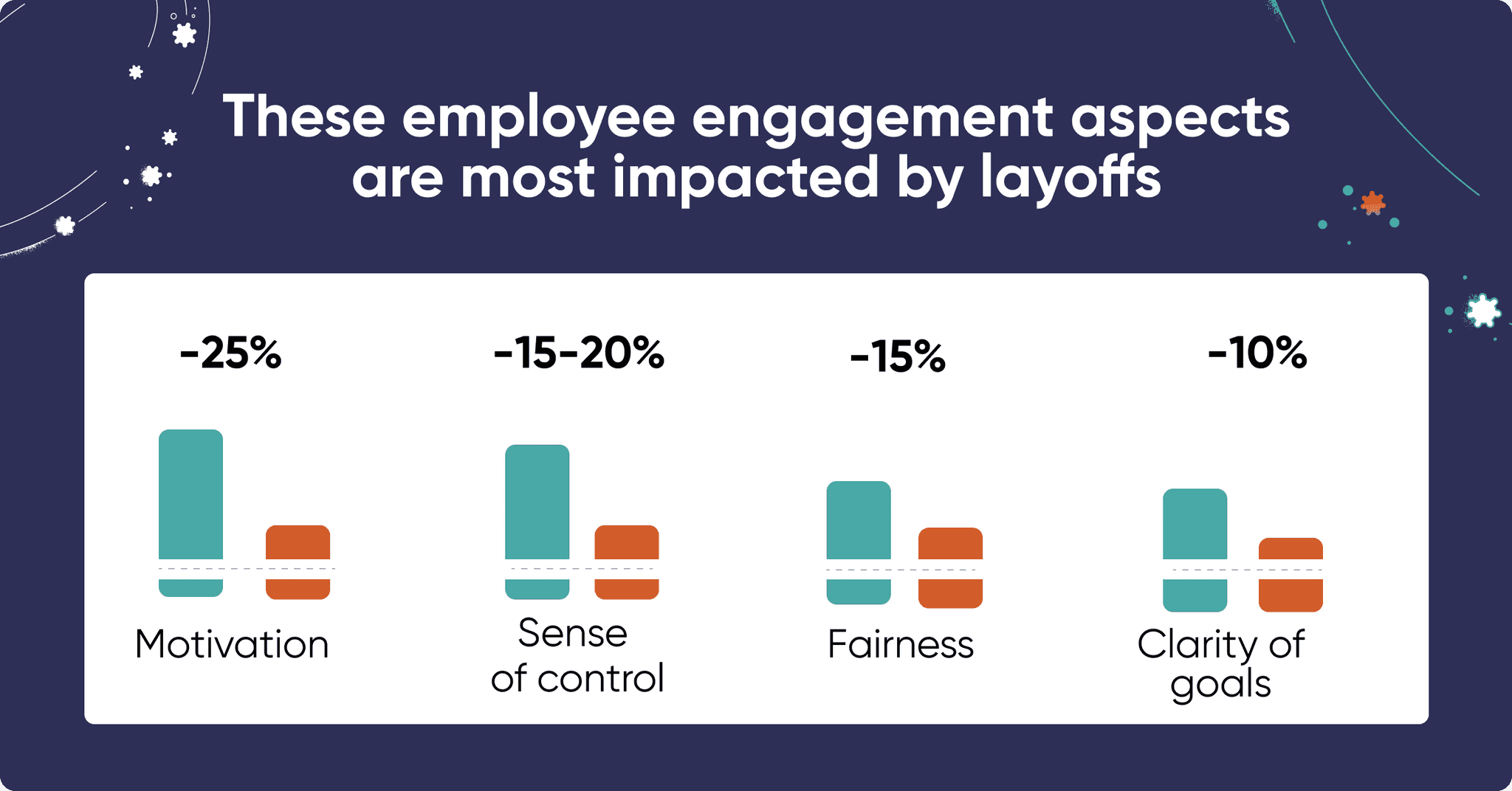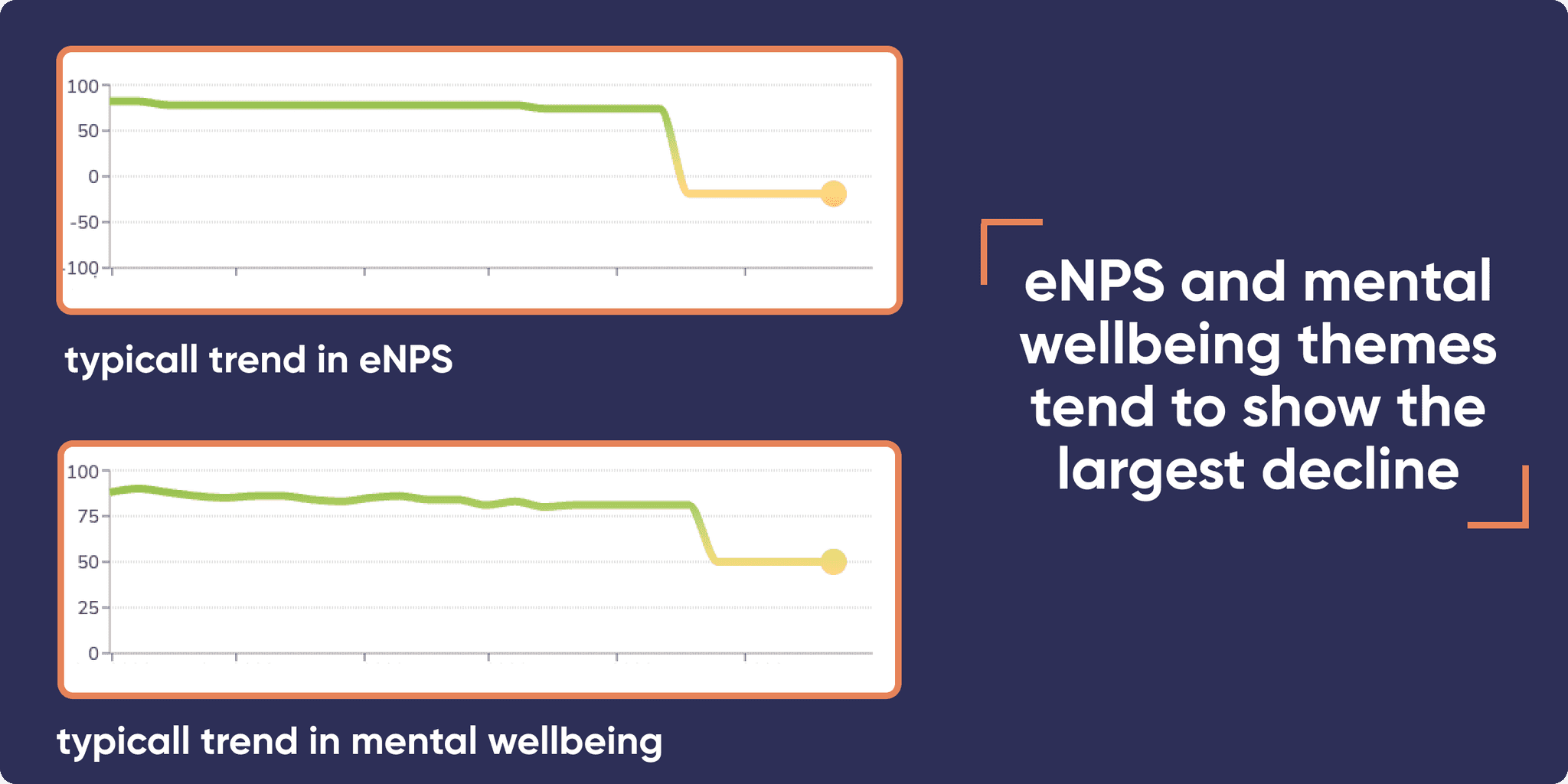Case study
Teamspective’s Pulse surveys detect impacts of layoffs accurately, and help companies lead towards better outcomes
Background
An increasing number of layoffs have been announced during the past year as the economic uncertainty has continued. This analysis based on real-life data depicts how the impacts of layoffs can be accurately assessed and mitigated with Teamspective’s pulse surveys.
Summary
- Pulse surveys measure how employees are impacted, in real time. Most and least affected aspects of employee experience and engagement can be accurately identified.
- Pulse surveys proved to be a safe channel for employees to give feedback even during uncertain times
- Leaders can start monitoring and supporting the organization’s recovery immediately.
Sometimes layoffs can be the only feasible alternative for ensuring a company’s long-term viability. Firing people is never fun. However, the way layoffs are handled and followed up on can make the difference between devastating and survivable outcomes for the company culture and employee wellbeing.
To ensure the best possible outcome from the restucturing, organizations should not just carefully plan the process but also ensure that negative impacts are tracked and addressed timely. In this case study, we describe how Teamspective’s pulse surveys can quickly and accurately detect what impacts layoffs have on employees, and what leaders should focus on in order to mitigate further issues.
Teamspective’s Pulse Surveys - brief overview
Teamspective’s Pulse Surveys help organizations measure the most crucial metrics for employee engagement, wellbeing, and collaboration, asking about the most important and fast-changing topics most frequently. Answering is as easy as it gets, directly in Slack or MS Teams, which ensures high response rates even if times of lower motivation. Advanced dashboards for analyzing results help leaders understand organization-wide and team-specific issues, monitor trends over time, and ensure sustainable improvement.
Which aspects of employee engagement are impacted the most?
According to Teamspective’s insights, layoffs have the largest effect on how people feel about working in the company and whether they are willing to be part of this organization in the longer term. A clear, immediate impact is clearly seen on motivation, clarity of goals and equity:
- Motivation: 25% decrease on average
- Sense of control: 15-20% decrease on average
- Fairness: 15% decrease on average
- Clarity of goals: 10% decrease on average
These changes cannot stay unnoticed, and organizations who experienced the described declines commonly see a significant impact on their company-wide wellbeing metrics and their eNPS score:
- eNPS: >100% decrease on average (i.e. the score almost inevitably turns from positive to negative)
- Wellbeing: 35-40% decrease on average
These changes in metrics predict an increased risk of employee churn. Resulting departures also have a high likelihood of causing turnover contagion, i.e. further lowering the threshold for others to consider changing jobs. (Read more about turnover contagion and the ways to prevent it in our blog post)
Which aspects of employee engagement stay unchanged?
Despite the huge negative impact on motivation, wellbeing, and clarity of goals, some things remain unchanged even after the layoffs. Relationships between employees may actually be strengthened, and the existing processes might continue to support effective working – as long as they do not rely on a single person to make all the decisions.
Though people’s expectations of fairness may have been violated, organizations typically don’t notice negative changes in inclusion-related themes or in the ways people are supporting each other. For example, in some cases topics such as belonging increased almost by 20% during difficult times.
Additionally, overall team effectiveness can remain intact immediately after layoffs are announced. Nevertheless, such themes as clarity of goals, psychological safety, and coordination see 4-10% decline on average. Negative impacts on team effectiveness might be noticed later, and it remains crucial to monitor these trends in the following weeks and months.
What can leaders do to mitigate the impact of layoffs?
With pulse surveys, leaders can monitor both company-wide and team-specific changes. After layoffs have been announced, it is crucial to keep measuring the many aspects of employee experience and team effectiveness, to identify the most impacted areas and focus mitigation efforts there. This real-time information helps you focus internal communication on the right things and start initiatives to address these issues early.
Though company-wide action plans are important, do not forget that each team may be affected differently and have their own pain points. Make sure that your team leads take ownership of discussing and addressing uncovered issues directly with their teams..
During hard times it’s important to focus on maintaining growth-orientation and hope for a better future. Nobody enjoys dwelling on the current issues. Pulse surveys can guide leaders to have meaningful and useful discussions about the topics that need it and avoid using time on discussions about the less-impacted themes.
Finally, remember that even though certain themes are more likely to be seriously impacted, trends may differ from company to company. Pulse surveys are a valuable tool that not only makes people feel heard, but allows prioritizing initiatives, addressing issues early, and ensuring a sustainable recovery of your organization.

